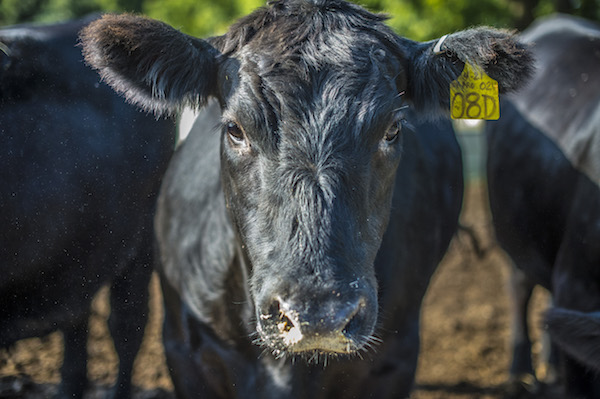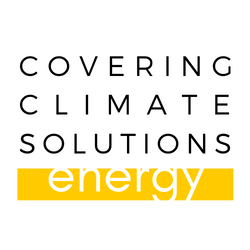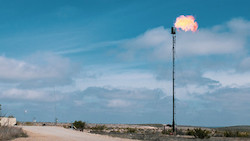SEJournal Online is the digital news magazine of the Society of Environmental Journalists. Learn more about SEJournal Online, including submission, subscription and advertising information.
 |
| The largest contributor of methane emissions from human activity comes from the digestive process in livestock. Experiments are underway to see if changing their feed to seaweed might help. Photo: U.S. Department of Agriculture, Flickr Creative Commons (Public Domain Mark 1.0). |
Covering Climate Solutions: Methane, a Key Global Warming Source, Is Targeted by Nations
By Nushin Huq
Methane is the second most important greenhouse gas, after carbon dioxide, contributing to climate change, and in recent years its growth has been accelerating.
 |
A key problem: While methane has a short atmospheric life, it traps heat 28 times more effectively than CO2 over a 100-year period.
But a recent study found an alarming trend: While oil and gas activity have slowed since the pandemic and despite declining methane emissions from fossil fuels, the atmospheric concentration of methane accelerated in 2020. And 2021 set another milestone. One possible explanation is a slowdown in the chemical reaction that cleans up methane from the atmosphere.
The main sources of methane emissions from human activity within the United States include digestive processes from domestic livestock, natural gas systems, landfills, domestic livestock manure management, coal mining and petroleum systems, according to the U.S. Environmental Protection Agency data.
The reduction of methane has gained more prominence worldwide. In 2021, more than 90 nations signed a global methane pledge, promising to pursue a 30% cut in emissions by 2030.
In the United States, the successful reduction of methane emissions, especially in the oil and gas sector, will rely on both federal and state regulations. The EPA has issued proposed rules to heavily regulate methane emissions from the oil and gas industry. Some companies, meanwhile, have begun voluntary efforts to reduce methane emissions.
Cutting human-caused methane emissions
by 45% this decade is believed possible
and would help keep warming beneath a
threshold agreed to by world leaders.
Methane reduction will also be key to achieving the goals of the 2015 Paris Climate Agreement. In fact, cutting human-caused methane emissions by 45% this decade is believed possible and would help keep warming beneath a threshold agreed to by world leaders, a 2021 United Nations Environment Programme report found.
A separate report, also released last year, stated that not only is methane mitigation critical to climate change reduction but that it must be accomplished quickly.
Using existing technologies and moving rapidly to cut emissions could slow the rate of the planet’s warming by 30%, and a full-scale push using existing technologies could cut methane emissions in half by 2030, authors said in a study published in the journal Environmental Research Letters.
On the other hand, the report in ERL said, a slower implementation could result in an additional tenth of a degree of global-mean warming by 2050 and a faster warming rate.
Here’s a look at key methane sources and possible solutions contributing to emissions reductions.
Livestock
The largest contributor of methane emissions from human activity in 2020 came from what is called enteric fermentation, the digestive process in livestock, according to a 2022 EPA-published report. The report, Inventory of U.S. Greenhouse Gas Emissions and Sinks: 1990-2020, states that enteric fermentation made up almost 27% of human-related methane emissions. That’s a 7.2% overall increase from 1990. The increase generally follows the increase in cattle population, the report said.
- Solutions to explore: There is evidence to suggest that changing livestock feed to seaweed can reduce methane emissions from cattle, but results from such studies had highly variable results. There are also certain practical and regulatory hurdles that would need to be considered. This includes producing the volumes of seaweed needed to feed cattle, in addition to U.S. Food and Drug Administration regulations around feeding seaweed to cattle. Reporters interested in this topic can read a number of studies published on this topic (here and here).
Fossil Fuel Activity
Natural gas activities were the second largest contributor in the US (25.4%) in 2020, according to EPA data. That doesn’t include methane emissions from abandoned wells.
- Solutions to explore: Watch for movement on federal rules. In June 2021, President Joe Biden signed a bill repealing the Trump-era rule that had rolled back the Obama administration’s 2016 regulations to reduce methane emissions. The reinstated rules, designed to curb leakage of that potent greenhouse gas at facilities built or modified since 2015, include requiring companies to use technology to detect and fix leaks at oil and gas wells.
Also, in November 2021, the EPA issued proposed rules that aimed to reduce methane and other harmful air pollution from both new and existing sources in the oil and natural gas industry. The proposal would expand and strengthen emissions reduction requirements that are currently on the books for new, modified and reconstructed oil and natural gas sources, and would require states to reduce methane emissions from hundreds of thousands of existing sources nationwide for the first time. By including existing sources, the proposed rules expand on Obama-era regulation.
Landfills
Landfills were the third largest contributor, although there has been an overall decrease of about 38% since 1990. This may be related to increased landfill gas collection-and-control systems and a reduction of decomposable material like paper, food scraps and yard trimmings in our landfills over time.
- Solutions to explore: The UNEP’s 2015 report on the outlook for global waste management discusses effective waste management as an entry point for sustainable development. As indicated in the EPA inventory of U.S. greenhouse gas emissions, methane emission reduction could also be linked to reduction of decomposables in landfills. Reporters can look at curbside composting programs and their efficacy. These include curbside yard clipping collection, food scrap collection or private companies and startups that pick up customer compostable food waste in return for compost.
Flaring/Releases
A prominent contributor to methane emissions by the oil and gas industry is intentional oil-well releases and flaring of natural gas, including methane. The industry considers these waste products. In oil-producing areas, it’s often easier to release or burn gases than build pipelines.
 |
| Intentional flaring of natural gas, including methane, is another contributor to emissions. Regulation is largely by states. Above, flaring in a West Texas oil field. Photo: Jonathan Cutrer, Flickr Creative Commons (CC BY 2.0). |
The proposed rules would also eliminate venting of associated gas from oil wells and require owners and operators to route the gas to a sales line where available. If there is no line available, they must use gas for power or another use on-site, or route to a flare that reduces methane emissions by 95%.
- Solutions to explore: In August, Biden signed the Inflation Reduction Act into law. A significant portion of the new law addresses climate change, including tackling methane emissions. The law has a methane emissions reduction program, which includes a waste pollution charge on excess tonnage of methane that operators emit above a threshold. The program goes into effect in 2024, which means that the EPA can charge emitters this fee even before its own pending regulations are implemented. The act’s methane program also charges the EPA to update its greenhouse gas reporting requirements for the oil and gas industry.
For reporters interested in learning more about pollution releases in local communities, the environmental group Earthworks uses optical gas imaging to make visible normally invisible air pollution from oil and gas facilities. Its website has an interactive map, and users can click and view video taken at facilities across the U.S. “No one is going to find methane unless you go out looking for methane,” said Earthworks’ Lauren Pagel during a recent Society of Environmental Journalists webinar, “Covering Climate Solutions: Containing and Monitoring Methane.”
Also, in mid-2023, MethaneSAT, a wholly owned subsidiary of the Environmental Defense Fund, will launch a satellite into space that will exclusively study and monitor global methane emissions. The goal of the satellite is to help with the quantitative data around global methane emissions, which is currently lacking. It will begin with collecting data from the oil and gas sector and then add other anthropogenic methane emissions. Data collected will not only quantify emissions from high-emitting sources, but scientists will be able to aggregate emissions and track changes over time. “Unless we know how much is being emitted, where the emissions are coming from, and who/what is responsible, we cannot mitigate those emissions,” added Ritesh Gautam, EDF lead senior scientist, during the SEJ webinar.
State movement
Under the current regulatory environment, the regulation of flaring has been left largely to state regulators. The Energy Information Administration releases a trove of statistics on natural gas and oil production, including state-level statistics on flaring and venting.
States with notable levels of flaring and venting include Texas, North Dakota, New Mexico, Alaska, Wyoming, Louisiana, Colorado, Montana and Utah, according to EIA statistics. There are also notable levels of flaring and venting offshore in the Gulf of Mexico.
In 2020, fossil fuel companies
operating in the Lone Star State
vented or flared 263,046 million
cubic feet of natural gas.
Texas is the national leader in venting and flaring of natural gas at oil wells. In 2020, fossil fuel companies operating in the Lone Star State vented or flared 263,046 million cubic feet of natural gas — an increase from 251,186 million cubic feet in 2019.
Texas regulators — oil and gas production in the state is regulated by the Texas Railroad Commission — haven’t taken comparably strong action on methane pollution. While agency regulations limit flaring, those rules are regularly waived. From 2013 to 2021, operators obtained 35,000 flaring permits without a single denial, according to the Environmental Defense Fund.
Also notable are wells in North Dakota and New Mexico, similar to those in Texas because the main product is oil. In states such as Colorado, the main product being produced is natural gas. This speaks to the economic incentive to get rid of natural gas through flaring.
- Solutions to explore: Natural gas vented or flared in North Dakota, the state with the second highest amount of vented or flared gas, dropped to 99,357 million cubic feet in 2020, from 205,278 million cubic feet in 2019. In July 2014, the state’s Industrial Commission adopted natural gas targets in response to increased flaring. Meeting the capture targets required a buildout of natural gas gathering lines from wells to processing plants, as well as a buildout of the processing plants to remove impurities and heavier hydrocarbons from the natural gas. In 2021, New Mexico regulators adopted the methane waste rule, with 98 percent of the methane from oil and gas operations to be captured by 2026.
Both of these states are oil-producing, like Texas. While the regulatory environments and structures are different, they could produce lessons for the Lone Star State. Also note that in 2020, Colorado regulators approved some of the most comprehensive rules around flaring and venting, hoping to further curb the practice in the state.
[Editor’s Note: For more on methane from the Covering Climate Solutions special report, see our Methane and Climate Change Toolbox and watch the recording of an SEJ virtual webinar, "Covering Climate Solutions: Containing and Monitoring Methane." Also from the SEJournal, see Backgrounders on methane and on the cleanup of orphan oil wells, as well as a Toolbox on tracking threats from local oil and gas wells and TipSheets on landfills leaking methane and on residential gas bans. Plus, check out methane-related headlines from EJToday.]
Nushin Huq is a Texas-based independent journalist who covers energy and the environment. Prior to freelancing, Huq was the Houston correspondent for Bloomberg Industry Group. Her work has appeared in Bloomberg, Fortune, Texas Climate News and Texas Lawbook.












 Advertisement
Advertisement 



